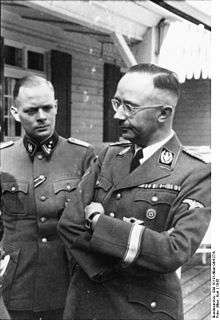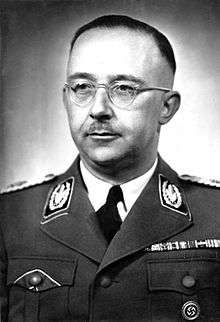Werner Grothmann
| Werner Grothmann | |
|---|---|
 Werner Grothmann (left) next to Heinrich Himmler in 1943 | |
| Born |
23 August 1915 Frankfurt am Main, German Empire |
| Died | 26 February 2002 (aged 86) |
| Allegiance |
|
| Service/branch |
|
| Years of service | 1933—1945 |
| Rank | Obersturmbannführer |
| Commands held | SS-Sturmbann Nº 13 |
Werner Grothmann (23 August 1915 – 26 February 2002) was a mid-ranking commander in the Waffen-SS of Nazi Germany and aide-de-camp to Reichsführer-SS Heinrich Himmler from 1940 until Himmler's death in 1945.
Biography
Grothmann was born in Frankfurt am Main in 1915. In his youth he studied economics and carved out a career as an accountant at a bank. In 1933 he joined the Schutzstaffel (SS) at 18 years old, and was assigned to the Junkerschule SS. On 20 April 1936, he was commissioned an SS-Untersturmführer (second lieutenant) and thereafter promoted to the rank of SS-Obersturmführer (first lieutenant) on 11 September 1938. He was made the commander the Deutsches SS Standarten in Munich, Germany.
At the beginning of the Second World War, he had already reached the rank of SS-Hauptsturmführer (captain) and was given command of SS-Sturmbann Nº 13, a unit of the SS Standarte Deutschland. He was mobilized with his unit during the conquest of France and was wounded in combat in June 1940.[1]
At the suggestion of Joachim Peiper, Grothmann was appointed second assistant to Reichsführer-SS Heinrich Himmler until July 1942, when he was promoted to aide-de-camp to the leader of the SS. As Himmler's aide, Grothmann accompanied him on all field visits. In 1943 he was promoted to SS-Sturmbannführer (major) and then to SS-Obersturmbannführer (lieutenant colonel).[2]
During the last few days of the war, Himmler, Grothmann and Heinz Macher traveled from Lübeck to Flensburg, where Himmler offered his services as second-in-command to the new interim government led by Karl Dönitz, successor to Adolf Hitler. Dönitz repeatedly rejected Himmler's overtures and initiated peace negotiations with the Allies. Himmler was formally dismissed from all his posts.[3][4]
Unwanted by his former colleagues and hunted by the Allies, Himmler attempted to go into hiding. He had not made extensive preparations for this, but he had equipped himself with a forged paybook under the name of Sergeant Heinrich Hitzinger of the Geheime Feldpolizei (Secret Field Police), which was a mistake since members of this organization were sought after by the liberation forces. Grothmann and Macher were both dressed as army privates.[5] Grothmann, Himmler, and Macher were stopped at a checkpoint, which had been set up by former Soviet POWs, on 21 May and detained. The three men were taken to an Allied barracks in Lüneburg on 23 May.[5] During a routine interrogation, Himmler admitted who he was, and was then taken to the headquarters of the Second British Army. During an attempted medical examination, Himmler bit into a hidden cyanide pill and died.[6] After Himmler's suicide, Grothmann and Macher were arrested.
Grothmann was taken to a barracks at Lübeck, where he was extensively questioned. He denied any knowledge of Operation Reinhard. Then he was taken to an SS prison camp. Grothmann served as a prosecution witness against several SS officials between 1946 and 1948,[7] but during the trial of Karl Wolff he denied having any knowledge of the Final Solution. After release from Allied internment, Grothmann was denazified, considered part of category III (Lesser Offenders), by a court in Freising in March 1949.[8]
Grothmann remade his life as a businessman and granted a few interviews in the 1970s in which he disparaged Himmler's character. Werner Grothmann died in 2002.
Notes
- ↑ Index SS-Grothmann, Profile
- ↑ Color photograph of Grothmann with Himmler in the field
- ↑ Longerich 2012, pp. 733–734.
- ↑ Manvell & Fraenkel 2007, pp. 239, 243.
- 1 2 Weale 2010, p. 410.
- ↑ Weale 2010, pp. 410, 411.
- ↑ Records of the United States Nuernberg War Crimes trials Interrogations 1946-1949 (PDF; 186 kB), published 1977
- ↑ Institut für Zeitgeschichte: Werner Grothmann – Zeugenschrifttum (PDF; 1,8 MB)
References
- Longerich, Peter (2012). Heinrich Himmler: A Life. Oxford; New York: Oxford University Press. ISBN 978-0-19-959232-6.
- Manvell, Roger; Fraenkel, Heinrich (2007) [1965]. Heinrich Himmler: The Sinister Life of the Head of the SS and Gestapo. London; New York: Greenhill; Skyhorse. ISBN 978-1-60239-178-9.
- Weale, Adrian (2010). The SS: A New History. London: Little, Brown. ISBN 978-1408703045.
